Related Research Articles

Indian Classical Music is the classical music of the Indian subcontinent. It is generally described using terms like Shastriya Sangeet and Marg Sangeet. It has two major traditions: the North Indian classical music known as Hindustani and the South Indian expression known as Carnatic. These traditions were not distinct until about the 15th century. During the period of Mughal rule of the Indian subcontinent, the traditions separated and evolved into distinct forms. Hindustani music emphasizes improvisation and exploration of all aspects of a raga, while Carnatic performances tend to be short composition-based. However, the two systems continue to have more common features than differences. Another unique classical music tradition from the eastern part of India is Odissi music, which has evolved over the last two thousand years.
Persian traditional music or Iranian traditional music, also known as Persian classical music or Iranian classical music, refers to the classical music of Iran. It consists of characteristics developed through the country's classical, medieval, and contemporary eras. It also influenced areas and regions that are considered part of Greater Iran.
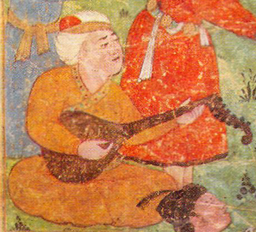
Barbad was a Persian musician-poet, music theorist and composer of Sasanian music. He served as chief minstrel-poet under the Shahanshah Khosrow II. A barbat player, he was the most distinguished Persian musician of his time and is regarded among the major figures in the history of Persian music.
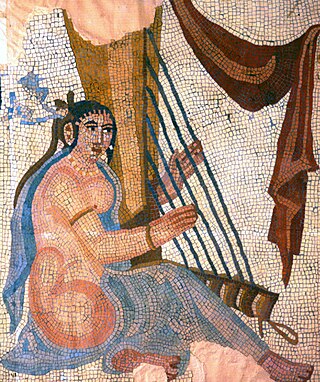
Sasanian music encompasses the music of the Sasanian Empire, which existed from 224 to 651 CE. Many Sasanian Shahanshahs were enthusiastic supporters of music, including the founder of the empire Ardashir I and Bahram V. In particular, Khosrow II was an outstanding patron, his reign being regarded as a golden age of Persian music.
Dastgāh is the standard musical system in Persian art music, standardised in the 19th century following the transition of Persian music from the Maqam modal system. A dastgāh consists of a collection of musical melodies, gushehs. In a song played in a given dastgah, a musician starts with an introductory gusheh, and then meanders through various different gushehs, evoking different moods. Many gushehs in a given dastgah are related to an equivalent musical mode in Western music. For example, most gushehs in Dastgāh-e Māhur correspond to the Ionian mode in the Major scale, whilst most gushehs in Dastgāh-e Shur correspond to the Phrygian mode. In spite of 50 or more extant dastgāhs, 12 are most commonly played, with Dastgāh-e-Shur and Dastgāh-e Māhur being referred to as the mothers of all dastgahs.

Ali-Naqi Vaziri was a composer, thinker and a celebrated player of the tar. He is considered a revolutionary icon in the history of 20th-century Persian music. His name was also transcribed as Ali Naghi Vaziri.

Hormoz Farhat was a Persian-American composer and ethnomusicologist who spent much of his career in Dublin, Ireland. An emeritus professor of music, he was a fellow of Trinity College, Dublin. Described by the Irish Times as a "gifted and distinctive composer of contemporary classical music," his compositions include orchestral, concertante, piano and choral music, as well string quartets and chamber works. He also wrote numerous film scores, including that of Dariush Mehrjui's 1969 film The Cow. However, his musicological research dominates his legacy; his writings on the music of Iran—a country which he insisted be called 'Persia'—were pivotal in ethnomusicology, particularly his acclaimed 1990 study The Dastgah Concept in Persian Music.
Bamshad or Bāmšād was a musician of Sasanian music during the reign of Khosrow II.
In traditional Arabic music, maqam is the system of melodic modes, which is mainly melodic. The word maqam in Arabic means place, location or position. The Arabic maqam is a melody type. It is "a technique of improvisation" that defines the pitches, patterns, and development of a piece of music and is "unique to Arabian art music". There are 72 heptatonic tone rows or scales of maqamat. These are constructed from augmented, major, neutral, and minor seconds. Each maqam is built on a scale, and carries a tradition that defines its habitual phrases, important notes, melodic development and modulation. Both compositions and improvisations in traditional Arabic music are based on the maqam system. Maqamat can be realized with either vocal or instrumental music, and do not include a rhythmic component.
In music, the dominant is the fifth scale degree of the diatonic scale. It is called the dominant because it is second in importance to the first scale degree, the tonic. In the movable do solfège system, the dominant note is sung as "So(l)".
Nagisa or Nakisa was a noted harpist and composer of Sasanian music in the royal court of Khosrow II.
Dastgāh-e Māhūr or Dastgaah-e Maahur is one of the seven Dastgāhs of Persian Music.
Tasnif is one of the several forms of Persian music and can be considered as the Persian equivalent of the ballad.
Dastgāh-e Šur is one of the seven Dastgāhs of Persian Music.
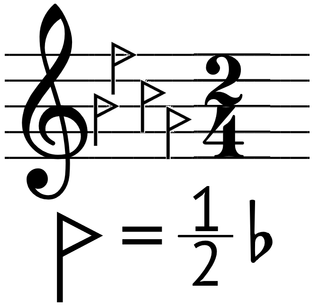
The koron, meaning "less than lower in pitch", is a symbol used in traditional Persian music in order to lower or "flatten" a written note by an interval smaller than a semitone. It is used to alter the pitch of a written note, similar to that of a sharp or a flat. It is written as a line with an open triangular head at the top-right. The koron symbol is positioned in the same manner as other accidentals in Western music, and can even be used in key signatures.
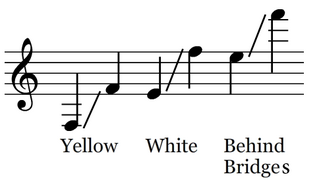
The santur, is a hammered dulcimer of Iranian origins.
Dastgāh-e Chahārgāh is a musical modal system in traditional mugham music and one of the seven Dastgāhs of Persian Music. Classically, Persian Music is organized into seven Dastgāhs and five Āvāzes, however from a merely technical point of view, one can consider them as an ensemble of 12 Dastgāhs.
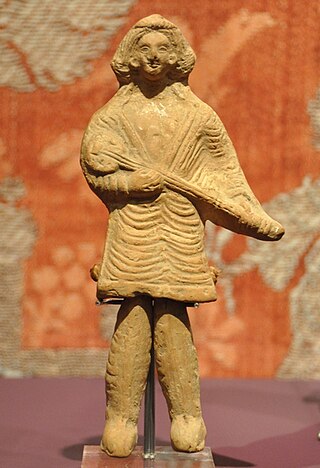
The Parthian Empire, a major state of ancient Iran, lasted from 247 BCE to 224 CE, in which music played a prominent role. It featured in festivals, weddings, education, warfare and other social gatherings. Surviving artistic records indicate that it involved both men and women, who could be instrumentalists or singers. Along with the older music of the previous Medians, Assyrians and particularly the Achaemenid period, Parthian music was crucial in laying the foundation for the golden age of subsequent Sasanian music.
Persian maqam is a notion in Persian classical music.

The Achaemenid Empire, a major state of ancient Iran, lasted from 550 BCE to 330 BCE, in which music played a prominent role.
References
- Marcus, Scott Lloyd (1989). Arab Music Theory in the Modern Period. Los Angeles, CA: University of California, Los Agenels.
- Farhat, Hormoz (2004). The Dastgah Concept in Persian Music. Cambridge: Cambridge University Press. ISBN 978-0521542067.